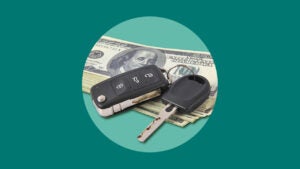Can you buy a car with a credit card?



Key takeaways
- It is possible to buy a car using a credit card, although it’s essential to have a clear payment plan in place and to check with your credit card issuer and the car seller beforehand.
- Buying a car with a credit card can be beneficial when using a rewards card or a card with a 0 percent introductory APR offer.
- However, the potential risks include high credit utilization and high interest rates if the balance isn’t paid off in time.
- Alternatives to using a credit card for a car purchase include auto loans, asking someone to co-sign, using cash or trading in an old car.
Buying a car is a huge decision that can take a lot of research and planning, including figuring out a way to pay for your vehicle.
Often, buyers take out an auto loan on a new car purchase, since most people don’t have enough extra cash to pay for a car outright. But depending on your circumstances, you could also opt to pay for a car with a rewards credit card or card with a 0 percent introductory APR offer. If you have a credit limit of around or over $20,000, for example, you could potentially cover the cost of a car and earn rewards points at the same time.
If this is an option you’re considering, here are a few things to know before you head to the dealership.
Can I buy a car with a credit card?
Yes, you can technically buy a car with a credit card, but before doing so, you should have a plan.
Since credit cards typically charge much higher interest rates than auto loans — an average of 20.12 percent at the time of writing — you’ll only want to charge a car to your credit card if you know how you’ll pay down the balance.
For example, it could make sense to pay for a car with a credit card if you have the cash in the bank to cover the purchase. That way, you can earn big rewards, then pay your balance in full before any interest accrues.
Charging a car purchase to your credit card can also make sense if your credit card has a 0 percent introductory APR offer. This would let you pay off your car without interest for a limited time and potentially earn rewards along the way. But depending on the cost of the car, you’ll need to make some large monthly payments. When your card’s introductory offer ends, you’ll be stuck paying your credit card’s ongoing variable interest rate.
How buying a card with a credit card works
Before you make your big purchase, here are a few steps you’ll want to take:
Step 1: Check with your credit card issuer
Whether you decide to buy a car with a travel credit card, use a card with a 0 percent introductory APR on purchases for a limited time or pick up a new credit card for the purchase, you’ll want to check with your credit card issuer to make sure the purchase will go through.
Even if your credit limit is high enough to accommodate the amount you want to charge, you’ll still need to notify your card issuer ahead of time. If you don’t, it’s likely a large and unusual transaction like a car purchase will be flagged for fraud.
If your credit limit isn’t high enough, you might have to ask for a credit limit increase. Just know that this could result in a new hard inquiry being placed on your credit report, temporarily impacting your score.
Step 2: Find a seller willing to accept credit cards as payment
This next part may prove tricky, since many car dealerships would prefer to steer you toward their own auto financing options instead of accepting credit cards as payment. Either way, you’ll need to ask the salesperson you’re working with if they’ll let you pay for some or all of the purchase with a credit card.
Some car dealerships will not accept credit cards as payment at all, in which case you should decide whether it’s worth looking elsewhere or you’re willing to use another payment method.
You may also benefit from discussing all the options with your salesperson. Some dealerships may let you pay for part of your car purchase with credit if you finance or pay cash for the rest. The only way to find out your options is by asking.
Step 3: Consider the potential risks
Many of the top cash back credit cards let you earn rewards for each dollar you spend and secure a 0 percent intro APR on purchases for a limited time, but these offers don’t last forever. If you plan to pay your card off before your introductory offer ends, but you fall behind, you could be stuck paying off thousands of dollars at an incredibly high interest rate.
There’s also potential risk to your credit score when you run up a credit card balance to buy a car. Your credit utilization — the amount you owe in relation to your credit limit — makes up 30 percent of your FICO score. So, if the cost of the car is most or all of your credit limit, your credit score could drop.
Finally, don’t forget credit options are limited if you have poor credit or fair credit. The top credit card offers for rewards or 0 percent offers will be out of reach for you if you don’t have at least “good” credit, which typically includes any FICO score of 670 or above.
Step 4: Create a plan to pay your balance off on time
If you’re taking advantage of a 0 percent intro APR on a new credit card you used to buy a car, you should strive to pay your balance off during that time period. Use a credit card payment calculator to figure out how much you would need to pay each month for this to happen.
If you run the numbers and find you cannot afford the monthly payment required to pay your car off before your intro APR period ends, then you may want to switch from plastic to an auto loan with a lower interest rate and better terms.
How can you tell? Here’s an example:
Say you want to purchase a car for $10,000 and you sign up for the Chase Freedom Unlimited®. There’s no annual fee, and you get a 0 percent introductory APR on purchases for 15 months (followed by a variable APR of 19.49 percent to 28.24 percent). Paying off $10,000 over those 15 months without interest would cost $666.67 per month.
If you can afford to pay that each month, you can reap the other benefits of this card, like the welcome bonus: Earn an additional 1.5 percent cash back on everything you buy (on up to $20,000 spent in the first year, worth up to $300 cash back). You’ll also earn a flat 1.5 percent back on your purchase.
If you’re not sure you can afford that monthly payment, don’t let the rewards lure you. Be realistic about what you can manage in payments each month. Otherwise, at the end of the intro APR period, you’ll be left paying the very high variable APR (19.49 percent to 28.24 percent) on any remaining balance.
Other ways to buy a car with a credit card
You don’t have to purchase and pay off a car with a credit card in full. Here are some alternative methods you can consider as well.
- Use a credit card for the down payment. Rather than using a credit card to cover the entire car purchase, consider using one for just the down payment instead. Most car purchases require money paid up front, often between 10 and 20 percent of the purchase. It may be more accessible for you to pay off that amount with a credit card instead. You can pay off the monthly car payments with a debit card or cash after that.
- Use a credit card to cover monthly payments. On the flip side, consider using a debit card or cash for the down payment and a credit card for the monthly payments thereafter. Not all auto loans allow the use of credit cards for monthly payments, but if yours does — and if you’re confident you can pay them off on time — then this could be a more digestible way to use credit for a car purchase.
Is it a good idea to buy a car with a credit card?
There are several factors to keep in mind when considering whether charging a large expense (like a car) to any credit card is a good idea.
Your credit utilization ratio
The closer you get to meeting your credit card’s limit, the higher your credit utilization ratio will be. Your credit utilization ratio represents the difference between the credit limit you have on your credit card and what you already owe.
Ideally, you want to keep your credit utilization ratio low to avoid any impact to your credit score. Maxing out your credit card is seen as a risk to potential lenders who may assume you’re tied up in debt you are struggling to pay off.
If you find yourself in a situation where you have access to a credit limit large enough to purchase a car, it is important to have a plan to pay it off before swiping your card.
0 percent intro APR
The rule of thumb to using a credit card is to never charge anything you can’t pay off immediately with cash, and the same rule applies here. Even if you are opting to use a card that offers a 0 percent intro APR period — typically between 12 and 18 months — you’ll want to establish a payoff plan to protect your financial health.
If you aren’t able to pay off the balance before the intro period ends, you’ll end up paying the card’s regular interest rate on the remaining balance. This could leave you with a hefty monthly payment if you purchase a car with a credit card and you can’t manage to pay it off before interest accrues.
Make sure you know exactly when your promotional APR runs out and what the standard variable APR will be so you can work on paying off your balance beforehand.
Rewards potential
A large purchase is an excellent way to maximize rewards. It can also make a lot of sense to use a specific card for a big ticket item if you’re trying to hit a high spending requirement for a generous welcome offer.
However, once again, this only makes sense if you have enough cash to pay off the card right away. You can’t justify meeting the spending threshold for a hefty sign-up bonus if you run into high interest charges.
Best credit card for buying a car
As long as your credit limit allows, and you have a payoff plan, any flat cash back card with a 0 percent introductory APR for new purchases can be a great option for buying a car. You’ll earn rewards on your purchase without having to worry about bonus categories, and can take advantage of the intro period to pay down the balance.
Alternatively, if you’re shopping for a car included in General Motors’ portfolio of brands, then the My GM Rewards® Mastercard®* could be your best bet for using a credit card to buy a car. This card stands out as a rewarding card to use for car purchases, service appointments, parts, accessories and protection plans because you can accrue points for these purchases or use points to pay for them.
Chevrolet, Buick, GMC and Cadillac are all GM brands, so new or pre-owned car purchases made with your My GM Rewards card at these dealers could earn the highest rewards.
Alternatives to using a credit card to buy a car
If you find yourself in a financial situation where buying a car with a credit card puts you in an enormous amount of debt, you should consider other options.
Here are a few alternatives worth considering:
- Car financing: Auto loans allow you to borrow the money you need to purchase a car. Auto loans typically come with fixed rates significantly lower than the interest rates on a credit card. If you are skeptical about car financing because you have bad credit, there may be lenders who are willing to work with you.
- Ask someone to co-sign: If you’re ready to consider car financing but concerned you won’t qualify due to your credit score, consider applying with a co-signer. You want to find someone with good credit who would help improve your chances of qualifying for a loan, ideally with a lower rate. A co-signer could potentially be a family member, partner or close friend willing to take on the responsibility.
- Use cash: Most people can’t pay for a car with cash, but if you find yourself in a situation where you saved up enough cash to buy a car, whether it be for your dream car or otherwise, that may be more financially feasible than using a credit card that could jeopardize your credit over time.
- Ask about trade-in value: If you already own a car, you may be able to trade it in and collect enough money to use it as a down payment on a new car. Even if you think your car may not be worth much, it never hurts to try.
The bottom line
Buying a car with a credit card can make sense if you can earn some rewards, save money on interest for a limited time or anticipate using that card for maintenance appointments or parts and accessory purchases.
Just remember to do the math and consider all the advantages and disadvantages before you take the leap. Using a credit card does let you access some perks, but you will only wind up ahead if you use credit responsibly and you have a solid plan in place to climb out of any debt you take on.
*The information about the My GM Rewards® Mastercard® has been collected independently by Bankrate.com. The card details have not been reviewed or approved by the issuer.




